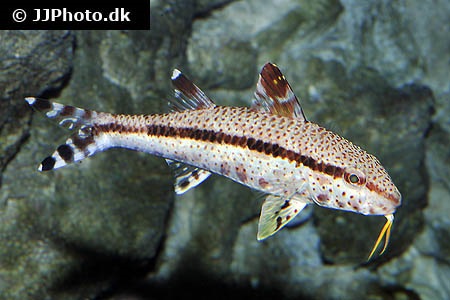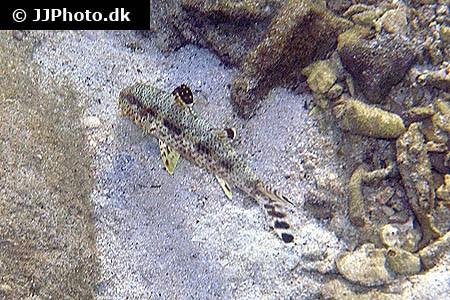Upeneus tragula


| Latin name | Upeneus tragula - Richardson, 1846 |
|---|---|
| Local name | Freckled goatfish |
| Family | Mullidae - Upeneus |
| Origin | East Indian Ocean, West Indian Ocean, Australia, Japan, The Red Sea, Indonesia, Central/West Pacific |
| Max length | 25 cm (9.8") |
| Minimum volume |
1500 l (396 gal) |
|---|---|
| Hardiness |
Average |
| Suitable for aquarium |
Experience, preparation and extra care required |
| Reef safe |
Reef safe with caution |
| Aggressiveness | Docile |
| Recommended |
Fish Larger crustaceans (Shrimp, crabs...) Other invertebrates Small crustaceans (Krill, mysis, artemia...) Zooplankton (Cyclops, pods...) |
|---|
This species is known to jump out of open aquaria.
This species can be a threat for small fishes, crustaceans, worms, snails etc.
This species searches through the sand for food, which can make the water cloudy and shakes up detritus.
In an aquarium their natural food source in the sand is quickly exhausted.
This species revels in swimming and requires an aquarium with ample space.
This species is very shy and docile, so one should be careful when keeping it with more aggressive fish.
Goatfish (Mullidae) have a very characteristic "beard" which they use when searching the sand for food. The aquarium should therefore have a large open area with both sand and coral gravel for example.
These fish are not particularly well suited to aquaria as they often die after a few months due to malnutrition.
To succeed with these fish, one must feed them a varied diet 4-5 times a day, this in addition, to them finding their own food in the aquarium.
It can be difficult to fulfil their dietry needs, as they quickly consume the natural food in the tank and the amount of feeding places a large strain on the aquarium.
They require a large amount of food when young, but less when fully grown.
Goatfish are considered predators, as they will eat small fish and crustaceans.
| Aquarium trade | Yes |
|---|---|
| Distribution | Eastern Indian Ocean to Western Pacific: from Andaman Islands to E Australia and to Japan and New Caledonia. |
| English common names |
Darkband goatfish Freckled goatfish Mottled goatfish Bar-tail goatfish Bartail goatfish Bar-tailed goatfish |
| French common names |
Capucin d'herbiers Capucin souris à bande sombre |
Scott W. Michael. 2004. Angelfishes and Butterflyfishes (Reef Fishes Series Book 3) TFH Publications / Microcosm Ltd. - (English)
Bob Fenner. Mulling Over the Goatfishes, Family Mullidae, Part I - Wet Web Media - (English)
Bob Fenner. Mulling Over the Goatfishes, Family Mullidae, Part II - Wet Web Media - (English)
Bob Fenner. Mulling Over the Goatfishes, Family Mullidae, Part III - Wet Web Media - (English)
Bob Fenner. Goatfishes in Indonesia, Family Mullidae - Wet Web Media - (English)

